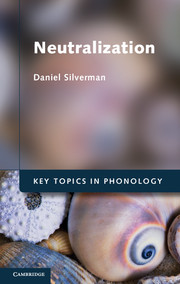Book contents
- Frontmatter
- Contents
- List of Figures
- Preface
- Acknowledgments
- 1 The rhyme and the reason of neutralization
- Part I Rhyme
- Section A Observation and description
- Section B False positives
- Section C Explanation
- 7 Ease of production
- 8 Ease of perception
- 9 Phonetic misperception
- 10 Semantic misperception: early proposals
- 11 Semantic misperception: recent proposals
- Section D Exemplification
- Part II Reason
- Glossary
- References
- Language index
- Subject index
9 - Phonetic misperception
Published online by Cambridge University Press: 05 November 2012
- Frontmatter
- Contents
- List of Figures
- Preface
- Acknowledgments
- 1 The rhyme and the reason of neutralization
- Part I Rhyme
- Section A Observation and description
- Section B False positives
- Section C Explanation
- 7 Ease of production
- 8 Ease of perception
- 9 Phonetic misperception
- 10 Semantic misperception: early proposals
- 11 Semantic misperception: recent proposals
- Section D Exemplification
- Part II Reason
- Glossary
- References
- Language index
- Subject index
Summary
A major thread woven into in the sturdy fabric of Ohala's research program (for example, 1981, 1989, 1990, 1992, 1993a, 1993b) is a prominent role for listeners as progenitors of sound change. Now, while traditionally, the term “sound change” does not encompass patterns of neutralization (rather, it refers to diachronic modifications such that the overall functional organization of the system remains unchanged), and while Ohala himself often discusses sound change in this traditional sense, nonetheless, his scholarship has far-reaching consequences that may quite readily encompass such patterns. Indeed, his research occasionally forays into the relevant domain of assimilation, a common source of neutralization. Consequently, in this chapter, we consider Ohala's ideas in some detail as they specifically relate to our present concerns, that is, how listeners' “phonetic misperceptions” may bear on patterns of neutralization. I begin with some of the basics of Ohala's extremely important and influential program, then move on to consider some outstanding remaining issues.
So, a little background first. As also considered (and summarily rejected) in Chapter 7, Ohala observes that traditional approaches usually trace the locus of sound change to speakers, not listeners, typically invoking “ease of articulation” argumentation. Ohala challenges this tradition by proposing that listeners take an active (if, of course, unconscious) role in sound change, in the form of formulating hypotheses about the articulatory intentions of the speakers they hear. The source of this role for listeners, Ohala argues, is an occasional inherent ambiguity in the speech signal: given the imperfect match-up between articulatory and acoustic states – most crucially for Ohala, the many-to-one relationship between articulation and acoustics – listeners may have multiple ways of interpreting the acoustic signal as articulated by speakers. On occasion, such ambiguous speech signals may be interpreted by listeners in a way that does not exactly match speakers' articulatory intentions. If such mismatches iterate and propagate, a sound change may be set in motion.
- Type
- Chapter
- Information
- Neutralization , pp. 101 - 109Publisher: Cambridge University PressPrint publication year: 2012



